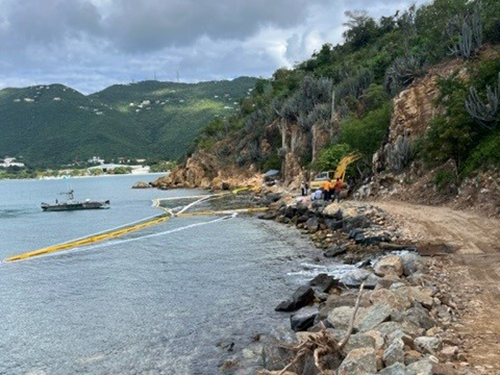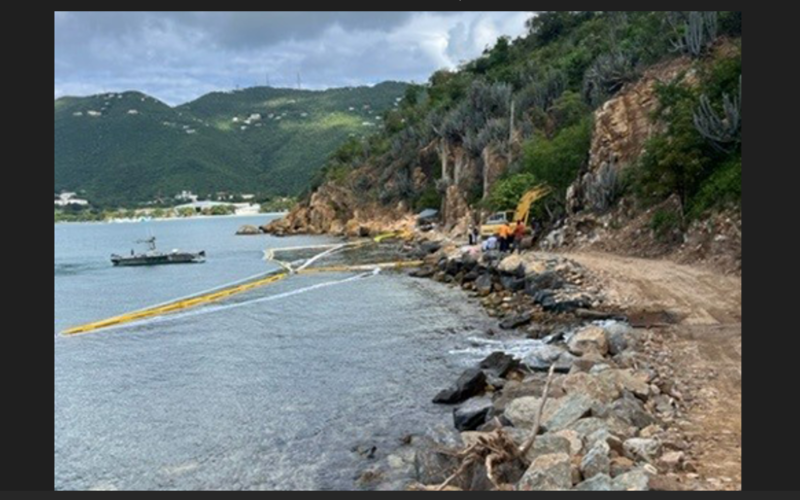CHARLOTTE AMALIE — The Virgin Islands Water & Power Authority released diesel fuel from an oil tank at its plant in Havensight, St. Thomas on October 25, 2023.
The spill of No. 2 diesel was discharged outside the tank’s secondary containment. Original spill estimates of 33,600 gallons of diesel have since been updated and calculated to be over 50,000 gallons.
At the request of the U.S. Coast Guard (USCG), NOAA’s Office of Response and Restoration (OR&R) has been providing scientific support for the USCG’s oversight of the clean-up operations at the plant.
The NOAA Scientific Support Coordinator provided a preliminary assessment of oil fate and movement in the event the release migrated into the adjacent waterway, as well as information about resources at risk for nearby Lindburgh Bay and Krum Bay.

Boom seeking to contain oil spill at Krum Bay in St. Thomas.
In January 2024, the USCG Federal On-Scene Coordinator (FOSC) requested continued support from NOAA for the ongoing response, through the initial assessment phase that is estimated to last about three months. Additional response and remediation actions are expected to continue beyond the assessment period until regulatory and environmental endpoints are determined and met.
In addition to NOAA, the USCG has been communicating and consulting with local government agencies, stakeholders, and partner members from the Caribbean Regional Response Team, including Virgin Islands Department of Planning and Natural Resources, the Environmental Protection Agency, U.S. Fish and Wildlife Service, the U.S. Army Corps of Engineers, and the Department of Transportation Pipeline and Hazardous Materials Safety Administration, among others.
“This is a long-term and complex response which includes several phases and matters that are being resolved with [the local power and water utility] to ensure the most diligent and effective clean-up of the site,” said Capt. Jose E. Díaz, USCG FOSC for the pollution incident.
Current clean-up operations remain actively focused on the recovery of the subsurface diesel material along the hillsides leading to Lindbergh Bay and Krum Bay, as well as the affected coastal area of Lindbergh Bay. Presently, clean-up crews are continuing irrigation tactics, using a high-volume, low-pressure flow of water to help move the subsurface diesel through seven natural land veins to established collection points, where the diesel is being recovered. The utility’s contractors are conducting weekly sampling for the response and management of an established collection system on the Krum Bay side of the site.
Clean-up operations include consultants using Light Detection and Ranging (LiDAR) technology to conduct a sub-surface site assessment and plume modeling of the affected terrain to help identify areas of free diesel product and provide recommendations for response recovery strategies. Once site assessment is completed, the utility will use the data to execute a drilling strategy to reach and recover the sub-surface diesel.
The FOSC Representative for the response has also initiated a re-evaluation of potential affected resources as part of an emergency consultation under Section 7 of the Endangered Species Act, to ensure that all trustees and stakeholders have considered all upcoming operational activities. Sea life and natural resources identified within Lindbergh and Krum Bays include the green and hawksbill sea turtles, bottlenose dolphins, whales, sea and shore birds, pelagic and reef fish, invertebrates, and benthic habitats. So far, there have been no signs of affected sea life or natural resources, however, responders continue to monitor.
For over two years, spill scientists from OR&R’s Emergency Response Division supported a spill response to a utility company in Florida, which had similar challenges and response considerations as this St. Thomas incident. The previous response is providing valuable lessons and guidance to assist with addressing this current incident response.
SOURCE: NOAA

